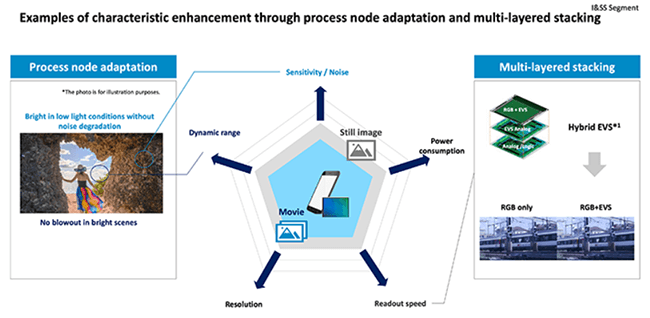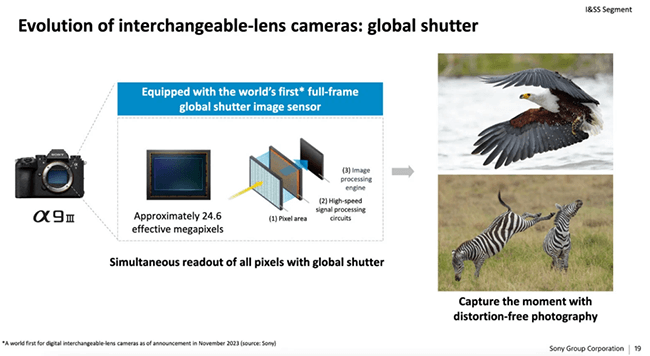According to news from SAR, on June 13, Sony held a "fireside chat" for investors and shared the latest demonstration content. Of particular interest was the discussion about the new three-layer sensor, a technology that will help enhance various sensor performances such as sensitivity and speed.

Sony is clearly pushing the boundaries of technology as it sees huge potential in the automotive sector—and this is also great news for photography enthusiasts. There is reason to hope that these innovative technologies will be applied to future Sony Alpha cameras.
From the June 2025 demonstration by Sony's Imaging & Sensing Solutions (I&SS) business, we can clearly understand the future direction of Sony's camera business. Image sensors remain at the core of Sony's strategy in fields such as mobile, automotive, industrial, and cameras. Sony predicts that by the fiscal year 2030, the sensor market related to cameras will grow at a compound annual growth rate of 9%, indicating that Sony will continue to invest in this field.
Interchangeable lens cameras (ILCs) are still a key focus. Sony emphasized the technological evolution of interchangeable lens cameras, including full-frame global shutter sensors, high-speed readout, low-noise performance, and higher energy efficiency—innovations directly targeting photographers and professional video creators.
Video has become a new growth engine. Sony is focusing on improving real-time performance and video quality across all markets (mobile, automotive, and especially interchangeable lens cameras). The boundaries between photo and video usage scenarios are gradually blurring, and Sony's focus is on hybrid performance (still images + video), which is also the core advantage of the Alpha and FX series cameras.

Next-generation sensor technology will drive differentiated competition. Sony is committed to multi-layer sensor stacking and advanced process nodes to enhance sensitivity, dynamic range, energy efficiency, and readout speed. These technologies will be directly applied to future Alpha and FX camera models.
Sony explains that enhancing processing capabilities at the sensor level can improve apparent dynamic range, sensitivity, noise performance, efficiency, readout speed, and resolution—though the last advantage is more applicable to video performance than still images. An additional sensor layer itself does not change resolution, but by improving the sensor's speed and performance, it may unlock new video recording modes. High-resolution image sensors are currently often limited by processing bottlenecks in terms of video resolution; thus, eliminating or reducing these bottlenecks could unleash more video performance.
Better readout speed benefits almost all aspects of a camera's performance, including rolling shutter, continuous shooting speed, and autofocus performance.
The theoretical dynamic range advantage is more complex. Better sensor-level image processing helps improve apparent dynamic range, but the actual dynamic range of a sensor depends on many factors, including the full-well capacity of sensor pixels and sensor-level noise performance. While processing affects noise, full-well capacity is a physical property of pixels, and adding more layers to the sensor might actually reduce full-well capacity by physically shrinking the pixels.
However, Sony already explained this situation back in 2021 when it announced the initial concept of a three-layer image sensor. As Sony previously demonstrated, the third layer can also be pixel transistors located below the photodiode layer, rather than a second pure processing layer.
Sony showcased this three-layer sensor architecture in 2021. The sensor described in the recent investor demonstration appears very similar, with roughly the same promises. The development and launch of image sensors take many years.
"Sony's new architecture is an advancement in stacked CMOS image sensor technology, which separates photodiodes and pixel transistors into different substrates that are stacked rather than placed side by side," PetaPixel wrote in late 2021. "Sony states that this new stacking technology enables an architecture that optimizes both the photodiode layer and the pixel transistor layer, thereby approximately doubling the saturation signal level compared to traditional image sensors and expanding dynamic range."
When this sensor will be applied to Alpha or FX series products remains unknown, but Sony Semiconductor Solutions has repeatedly proven its ability to manufacture breakthrough image sensors, such as the global shutter sensor in the a9 III and the fast, high-resolution stacked sensor in the a1 series. Sony remains firmly committed to the development of full-frame image sensors, with a bright future ahead.
Despite user criticism, Sony will continue to innovate. The launch of the FX2 (indirectly mentioned) reflects Sony's desire to fill the gap in the hybrid professional market, even if it leads to controversial models. Sony acknowledges user feedback and is accelerating the standardization of camera firmware and user interfaces.

Financial data shows strong support for this business. In the 24th fiscal year, the Imaging & Sensing Solutions division achieved record-high sales and revenue. Sony plans to invest nearly 930 billion yen in capital expenditures from 2024 to 2026, with approximately 50% allocated to advanced image sensor processes.
As part of its long-term goals, Sony is heavily investing in new sensor technologies, including improved multi-layer stacked image sensors. Sony has already used stacked sensors in many cameras, including the flagship a1 II, but these are two-layer sensors: one layer of photodiodes (which contain all the pixels for capturing photos) and a second layer of transistors below (for processing tasks). Sony's long-term goal is to add a third layer to the image sensor stack, which essentially means expanding processing capabilities and improving image quality. All else being equal, stronger processing capabilities at the sensor level are better.

There is no doubt that future Sony Alpha cameras will showcase some exciting new technologies at the sensor level. SAR hopes this will start with the new Sony A7V, which is expected to be released in late 2025.
Related Tags: Sony
